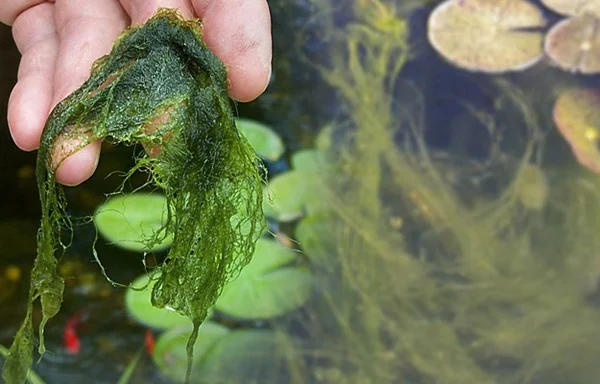Common Algae Found In Ponds and Tips For Treatment
/There are two common forms of algae that can occur in a koi pond, planktonic algae (green water algae) and filamentous algae (string algae). Best practices to control algae is to use a combination of chemical and natural methods to create a natural balance. There will be a quick bullet point summary at the end of the article to recap the information written below.
Planktonic algae, commonly known as green water algae, is a single cell microscopic algae which can engulf an entire pond very quickly. Turning the water into a thick green and sometimes brown color. This type of algae is very common in new ponds, ponds hit with constant sunlight and ponds with poor filtration.
New ponds can solve their green water algae problem by investing in aquatic plants. You should see clear water results with an appropriate amount of plants, enough to cover 20%-50% of your ponds surface, and a proper amount of time for your plants to grow. The plants will provide shade to the pond, resulting in less sunlight hitting the water. Since algae needs sunlight to grow, blocking off the light will make it easier to control. Poor filtration problems can also be fixed with the proper filters. Your filter should be large enough to handle the buildup of solid waste and be of sufficient size to grow a large colony of beneficial bacteria. Using a proper filter in combination with a UV light will give you the best result. Once you have established the natural methods to control algae, the chemical methods will be able to work efficiently. Algaecides are chemicals which kill or prevent all types of algae growth. These chemicals include chelated copper, simazine and potassium permanganate. It is important to understand how to use these chemical properly as too much can kill fish and plants, a proper way to use these chemicals will be posted on a later date.
Filamentous algae, commonly known as string algae, can grow in clear water. That’s because it competes with green water algae for nutrients in the water, thus it acts like a filter against green water algae. There are many causes for string algae, all mostly dealing with the bio-filter of the pond. The bio-filter may be too cold to function properly or too small, an inadequate cleaning cycle may cause a development of algae, thus the formation of string algae to compensate for the lack of filtration. Over application of antibiotics, parasite medicine or other chemicals commonly used in ponds may also contribute to the algae growth.
String algae does have some filtration and organic waste benefits. String algae acts as a filter by consuming the fishes waste. Also, removing all the string algae at once may be harmful to your fish, since oxygen levels will decrease. Before you decide to remove or kill all the string algae at once, think if they contribute to your pond in any way. With a proper plan in place to get the satisfactory filtration system installed, the string algae can be removed over the course of few weeks.
· Having shade will make algae easier to control
· All waste and nutrients settling on the pond's floor must be properly maintained
· Use a combination of natural filtration and algaecide methods
· Filtration must be on 24 hours a day
· String algae is healthy in proportion to the pond



